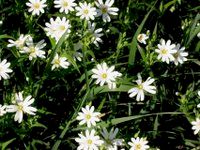|

Greater Stitchworts |
The Stitchworts, greater and less (Stellaria holostea), grow very abundantly as herbal weeds in all our dry hedges and woods, having tough stems which run closely together, and small white star-like (stellaria) blossoms.
These plants are of the same order (Chickweed) as the Alsine and the small Chickweed. Their second name, Holostea, signifies "all bones," because the whole plant is very brittle from the flinty elements which its structures contain. |
As its title declares, the great Stitchwort has a widespread reputation for curing the stitch, or sharp muscular pain, which often attacks one or other side of the body about the lower ribs.
In the days of the old Saxon leechdoms it was customary against a stitch to make the sign of the cross, and to sing three times over the part:
"Longinus miles lance?inxit dominum:
Restet sanguis, et recedat dolor!"
"The spear of Longinus, the soldier, pierced our Savior's side:
May the blood, therefore, quicken: and the pain no longer abide!"
Or some similar form of charm.
Gerard said of folk, in his day: "They are wont to drink it in wine (with the powder of acorns) against the pain in the side, stitches, and such like." But according to Dr. Prior, the herb is named rather because curing the sting (in German stich) of venomous reptiles. In country places the Stitchwort is known as Adder's meat, and the Satin Flower: also Miller's Star, Shirtbutton, and Milk Maid, in Yorkshire: the early English name was Bird's Tongue.
About, Plymouth, it is dedicated to the Pixies; whilst the lesser variety is called White Sunday, because of its delicate white blossoms, with golden-dusted stamens. These were associated with the new converts baptized in white garments on Low Sunday--the first Sunday after Easter--named, therefore, White Sunday.
But in some parts of Wales the Stitchwort bears the names of Devil's-eyes and Devil's-corn. Boys in Devonshire nickname the herb Snapjack, Snapcrackers, and Snappers.
Parkinson tells us that in former days it was much commended by some to clear the eyes of dimness by dropping the fresh juice into them. Again, Galen said: "The seed is sharp and biting to him that tastes it."
As a modern curative Simple, the Stitchworts, greater and less, stand related to silica, a powerfully remedial preparation of highly pulverized flint. This is because of the exquisitely subdivided flint found abundantly dispersed throughout the structures of Stitchwort plants; which curative principle is eminently useful in chronic diseases, such as cancer, rickets, and scrofula. It exercises a deep and slow action, such as is remedially brought to bear by the Bethesda waters
of America, and the powdered oyster shells of Sir Spencer Wells.
The fresh infusion should be steadily taken, a tea-cupful three times daily, for weeks or months together. It may be made with a pint of boiling water to an ounce of the fresh herb. Likewise, the fresh plant should be boiled and eaten as "greens," so as to secure medicinally the insoluble parts of the silica. This further serves against albumen, and sugar in the urine.
Herb Simples
The Primitive Simplers presented here show the way of life in other generations, it is not suggested or recommended trying them yourself. |
|
Garden
Herbs
Home
History of Herbs
Herb Gardening
Herbs for Beginners
Drying & Preserving Herbs
Indoor Herb Gardening
Herb Garden
Hints & Tips
Herbal
Cooking
Herb Chart
Using Herbs
Culinary Herbs
Herb
Oil and Vinegar
Herb Teas
Herb Candy
Herb Jelly
Herb Simples
Preface
Introduction
Alphabetical Listing

Trade
Recipes Online
Share your Recipes with others!!
|


